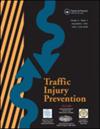机动车碰撞事故中颈椎脱位者脊髓损伤、切面骨折和脱位程度的相关机制和风险因素。
IF 1.6
3区 工程技术
Q3 PUBLIC, ENVIRONMENTAL & OCCUPATIONAL HEALTH
引用次数: 0
摘要
目的:机动车碰撞(MVC)是导致颈椎脱位的主要原因。这种伤害的机制尚不清楚,限制了伤害预防设备和策略的开发。机动车碰撞数据库包含乘员、医疗、车辆和碰撞的详细信息,这些信息在其他地方没有常规收集,为研究损伤机制和风险因素提供了独特的资源。本研究对机动车碰撞数据库中记录的颈椎脱位进行了全面的独立分析:方法:从三个 MVC 数据库中提取了流行病学、生物力学和损伤数据。建立了逻辑回归模型,以确定乘员、车辆和碰撞特征,以及与颈椎脱位程度(轴向或亚轴向)相关的整体(惯性或撞击)和区域(屈曲、压缩等)加载机制,以及与脱位同时发生的脊髓损伤(SCI)或面骨骨折:结果:整体或区域性损伤机制与颈椎脱位程度之间没有关联。轴下脱位通常是由于头部/面部受到安全气囊或上部内饰部件的撞击,或者是由于安全带对躯干的束缚。乘员年龄越大、体重指数越低、部分/无弹射、正面和侧面碰撞(与翻滚相比),发生轴下脱位的可能性就越大。在所有脱位中,发生 SCI 的可能性增加与撞击伤害、安全气囊未展开和完全弹射有关,而同时发生面骨骨折与存在区域压迫有关。与 "乘用车 "相比,严重撞击、部分弹射、"多功能车 "和 "货车和卡车 "与轴下脱位同时发生面骨骨折的风险更高:本研究的结果可用于指导未来的体外模型或计算模型模拟的加载模式,从而更好地了解颈椎脱位。本文章由计算机程序翻译,如有差异,请以英文原文为准。
Mechanisms and risk factors associated with spinal cord injury, facet fracture, and level of dislocation, in occupants with cervical spine dislocations sustained in motor vehicle crashes
Objective
Motor vehicle crashes (MVCs) are the leading cause of cervical spine dislocation. The mechanisms underlying this injury are unclear, limiting the development of injury prevention devices and strategies. MVC databases contain occupant, medical, vehicle, and crash details that are not routinely collected elsewhere, providing a unique resource for investigating injury mechanisms and risk factors. In this study, a comprehensive standalone analysis of cervical spine dislocations captured in MVC databases was performed.
Methods
Epidemiologic, biomechanical, and injury data were extracted from three MVC databases. Logistic regression models were developed to determine the occupant, vehicle, and crash characteristics, as well as the global (inertial or impact) and regional (flexion, compression, etc.) loading mechanisms associated with the level of cervical spine dislocation (axial or sub-axial), and the occurrence of spinal cord injury (SCI) or facet fracture concomitant to dislocation.
Results
There was no association between global or regional injury mechanisms and the level of cervical spine dislocation. Sub-axial dislocations were typically due to head/face impact with the airbag or upper interior components, or a result of seatbelt restraint of the torso. Higher occupant age, lower BMI, partial/no ejection, and frontal and side configuration crashes (compared to rollovers) were associated with a higher likelihood of sub-axial, versus axial, dislocation. Amongst all dislocations, an increased likelihood of SCI was associated with impact injuries, airbag non-deployment, and complete ejection, while concomitant facet fracture was associated with the presence of regional compression. Severe crashes, partial ejections, and “utility vehicles” and “vans and trucks” (compared with “passenger vehicles”) were associated with a higher risk of facet fracture concomitant to sub-axial dislocation.
Conclusion
The findings of this study may be used to inform the loading modes to be simulated in future ex vivo or computational models seeking a better understanding of cervical spine dislocations.
求助全文
通过发布文献求助,成功后即可免费获取论文全文。
去求助
来源期刊

Traffic Injury Prevention
PUBLIC, ENVIRONMENTAL & OCCUPATIONAL HEALTH-
CiteScore
3.60
自引率
10.00%
发文量
137
审稿时长
3 months
期刊介绍:
The purpose of Traffic Injury Prevention is to bridge the disciplines of medicine, engineering, public health and traffic safety in order to foster the science of traffic injury prevention. The archival journal focuses on research, interventions and evaluations within the areas of traffic safety, crash causation, injury prevention and treatment.
General topics within the journal''s scope are driver behavior, road infrastructure, emerging crash avoidance technologies, crash and injury epidemiology, alcohol and drugs, impact injury biomechanics, vehicle crashworthiness, occupant restraints, pedestrian safety, evaluation of interventions, economic consequences and emergency and clinical care with specific application to traffic injury prevention. The journal includes full length papers, review articles, case studies, brief technical notes and commentaries.
 求助内容:
求助内容: 应助结果提醒方式:
应助结果提醒方式:


